| Date: 1944 Apr 08/08 | A/C Type: B-17G Fortress | SN: 42-39856 | Code: AW-G | A/C Nickname: None. Believed Lane Tech of Chicago, but probably not. | 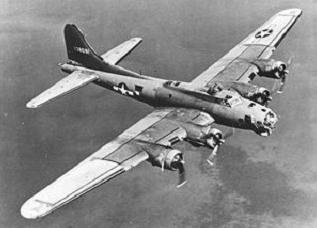 |
|||||
| File: 156 | Airforce: USAAF | Sqn/Unit: 96 BG - 337 BS | Mission/Raid: Rheine airfield | |||||||
| 1 | Pilot | 2Lt. Russell H. Gecks evaded | 9 | TG | S/Sgt. Sam A. Polito POW | |||||
| 2 | Co-pilot | 2Lt. Frank M. Deason evaded | 10 | LWG | S/Sgt. Howard F. Jones POW | |||||
| 3 | Nav. | 2Lt. Peter V. Lovero POW | 11 | |||||||
| 4 | B | S/Sgt. Leland F. Welch POW | 12 | |||||||
| 5 | RWG | S/Sgt. Peter E. Miskinis evaded | 13 | |||||||
| 6 | RO | T/Sgt. Clifton E. Hanley evaded | 14 | |||||||
| 7 | E | T/Sgt. Richard (Dick) E. Denny evaded | 15 | |||||||
| 8 | BTG | S/Sgt. Leon H. Rademacher POW | 16 | |||||||
After the raid had problems with three engines and lost height. Over Lake IJsselmeer turned east again for land and the crew to bail out (6000 ft). This was northeast of Urk. They and A/C came down in the centre of the Northeast Polder near Emmeloord, wetlands at the time. Five men were found by the Germans and became POW. The others evaded, sheltered by the resistance until liberated by passing US troops around Liège on 8 Sept. 1944 and 7 May 1945 (Miskinis). |
||||||||||
The crew bailed out northeast of Urk in a swampy area. This gave some cover. Nevertheless five of the crew (Nav, B, BTG, LWG and TG) were arrested by German soldiers in the night of 8/9 April at 02:00h. Gunner S/Sgt. Peter Miskinis was hurt during the landing and stumbled to the dike north of Urk. Here he was found and helped into Urk the same night. The four men that bailed out last; pilot Russell Gecks, co-pilot Frank Deason, radio operator Clifton Hanley and engineer Dick Denny, came together on the ground more in direction of Emmeloord and could evade.
There is discussion on the name of Geck's aircraft. Whether it was Wacky Woody or Lane Tech of Chicago or had no nickname. The last seems to be the case. Fact is that this particular aircraft was a B-17G (with chin turret, see also crew photo below) and had serial number 42-39856. The German report confirms no. '239856' on crash location 'Emeeloort, NE of Polder' (Emmeloord, in the Northeast Polder). See image below. The 'C' or 'G' above the number in German report is the 'C in square', the sign on the tail for the 96 Bomb Group, but it can also stand for the 'G' this aircraft had on the tail and fuselage as squadron code: AW-G. See image of AW-G further below.

Name 'Lane Tech of Chicago'.
Concerning the name, nobody of the crew of 39856 or any other source proves that this B-17G ever had a nickname or nose art. It was without name when it came down. Where the B17 'Lane Tech of Chicago' is, is unknown at this time (September 1st, 2017), but the Lane Tech B-17 was probably a B-17 type F, an earlier type without chin turret. More on this further down this page.
Peter Miskinis (Photo below. Bike bread deliverer in New York before the war). He was given shelter in the grocery store of the Brouwer family in Urk (photo below) for 10 days and nights. Then he was moved by resistance man Harmen Gerssen over the Lake by the ferry boat Urk-Enkhuizen. They took the train at station Bovenkarspel-Broekerhaven to Zaandam. In hamlet Zaandijk Miskinis, who was wounded in the lower leg, found shelter for over a year in the house of Mr. and Mrs. de Koning (milkman) until the war was over 8 May 1945. It is remarkable how many American airmen were hidden in Zaandijk throughout the war. It was a favorite safe house location with strong resistance movement, used by the Peter van den Hurk/Joke Folmer pilothelpers group (both awarded USA Medal of Freedom with Gold Palm).

Mission
Thanks to T/Sgt. Dick Denny's post war narratives and our files, the course of events of 8 April 1944 and period thereafter can be quite well put together. Denny:
"April 8th 1944 began as so many English days, with cloud and a light mist. It was the day before Easter. Had I known it was to be my last mission, I might have attended sick call. On this mission we were to bomb an airfield south of Hamburg. We crossed the border between Holland and Germany. No sight of fighter planes. As we neared our target, Lt. Gecks reported a Flak barrage. The Sky was the blackest I had ever seen with Flak, we heading right into it. I could see bombs streaming from the B-17's".
"When co-pilot tried to automatically close the bomb doors, they didn't work. This meant I had to leave my top turret and crank up the doors by hand. Altitude was high, 20.000 ft (6000 m). It was futile what I did, because they did not come up. The air seemed to be exploding around me. I went into the cockpit, pilots were fighting to control the plane. Holes from Flak hits appeared in the sides. No one was wounded. No. 2 engine had its controls shot away and was windmilling. Suddenly we lost it. No. 1 engine was losing oil and trailing smoke. We started throwing out equipment to lighten the plane. We had been hit hard. Hanley the RO was calling a May Day over the radio. Germany was now fading in the distance and we entered Holland, losing altitude. No. 4 engine was now also giving trouble. We were approaching the Zuider Zee at 10.000 ft. As we flew over it, it came clear we would not make it to the other side. Even from our altitude of 8000 ft., the other side was nowhere to be seen. Lt. Gecks made a 180° turn. As we came back over land he gave the order to jump".
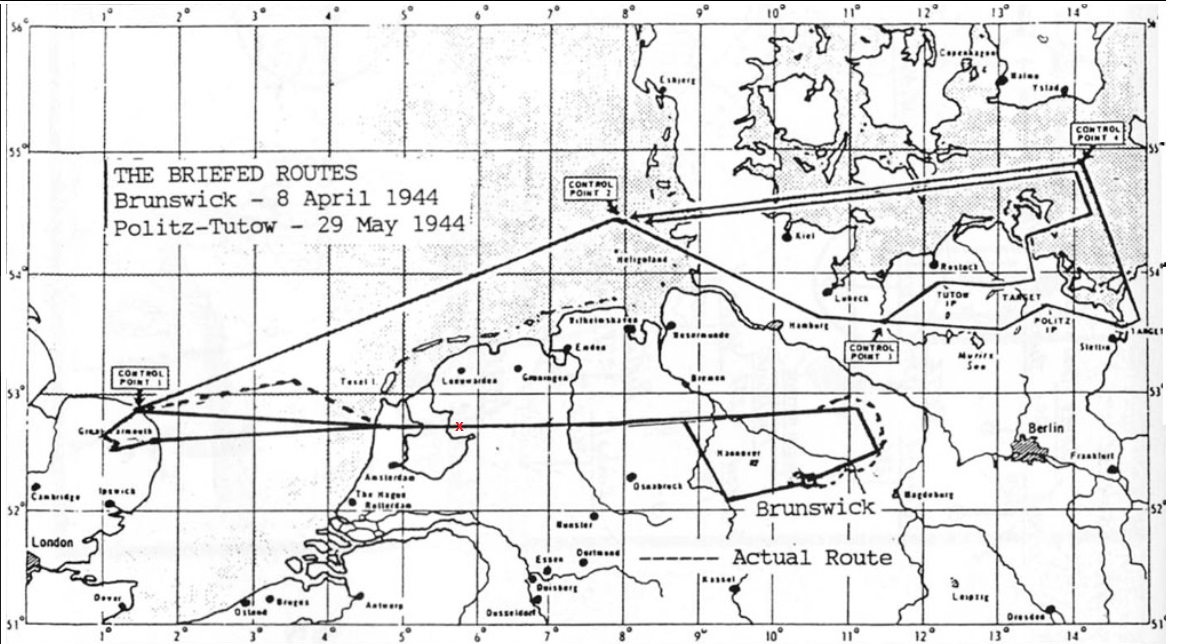
The Northeast Polder.
"I saw the ground about 7000 ft below, I jumped. My helmet flew off seconds into the jump. Looking around during my silent descent, I noticed the plane burst into a ball of flames as the fuel tanks exploded. On the ground I rolled the chute into a small package, stomped it into the ground and threw some brush over it. The place were I landed had recently been reclaimed from the sea (The Northeast Polder). Before the war, a half circular dike was build here in sea that had closed off some 12 x 16 miles of water, which had been pumped out. No trees had been planted yet. It was flat as the panhandle of Texas".
"A droning noise warned me to take cover. It sounded like a small Piper Cub, looking for those who were shot down. I dashed for the bank of a canal about a block away. Covered myself with small brush and whatever I could find for camouflage. The searcher flew on and we four, Gecks, Deason, Hanley and myself came out of hiding and came together. As I looked up, I saw the B-17's heading home. Standing in an open field we were confronted with the question 'what next?' Should we walk north and hope to catch a boat to Sweden? Or go south and hope to make our way out to Spain?
Nice course objectives of the four Americans dressed in flying suits... A bit naive in geography, lack of ID-papers, language ability and the circumstances in Nazi occupied Europe. Between them, Sweden and Spain were thousand miles, 500 guarded bridges and a million German soldiers. In reality the men were trapped inside the bowl the Northeast Polder was. In the far distance there were only a few guarded exits out. Soon the men realized they had to find someone of the Dutch underground for help.
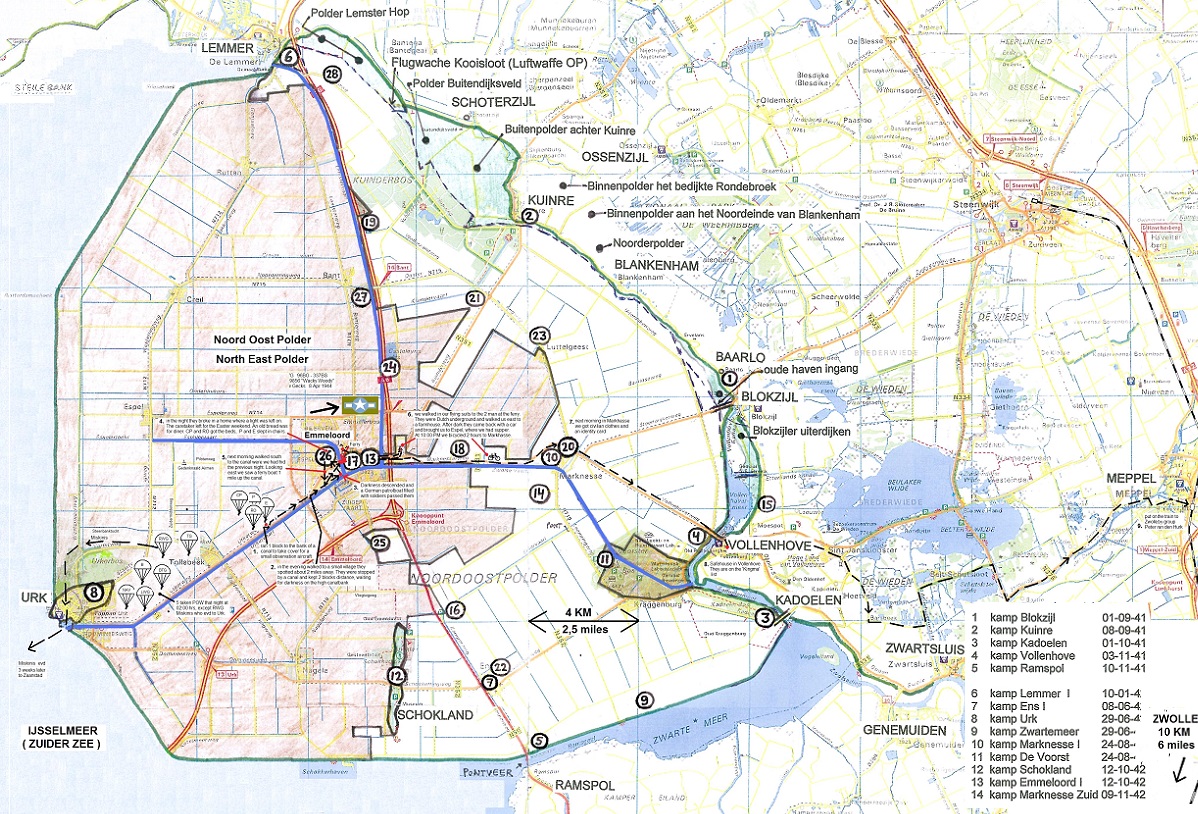
Under point 26 on above map, Sgt. Denny: "in the polder night was approaching and we had spotted a small village about 2 miles away (Emmeloord under construction). So we walked within 2 blocks of it but were stopped by a canal. The canal had high banks on either side, built to hold the water in. The water level was much higher than the surrounding land. It was nearly dark when suddenly the faint sound of a motor caught our attention. I peeked over the bank and saw a German patrol boat fast approaching, filled with German soldiers looking for us. We lay quietly on the other side and heard them pass. They were speaking in guttural tones, with a sense of humor, for we heared them laughing as they passed 15 feet (5 meter) from us. After passing, we continued on into the dark village, noting that there was a light on in only one home. No lights in the rest of the village. Hanley and I cautiously approached the lighted house and were delighted to find it empty, for the caretaker of the village had gone some place for the Easter weekend. Photo below: Emmeloord under construction 1944 (photo on website Oud Ommen).
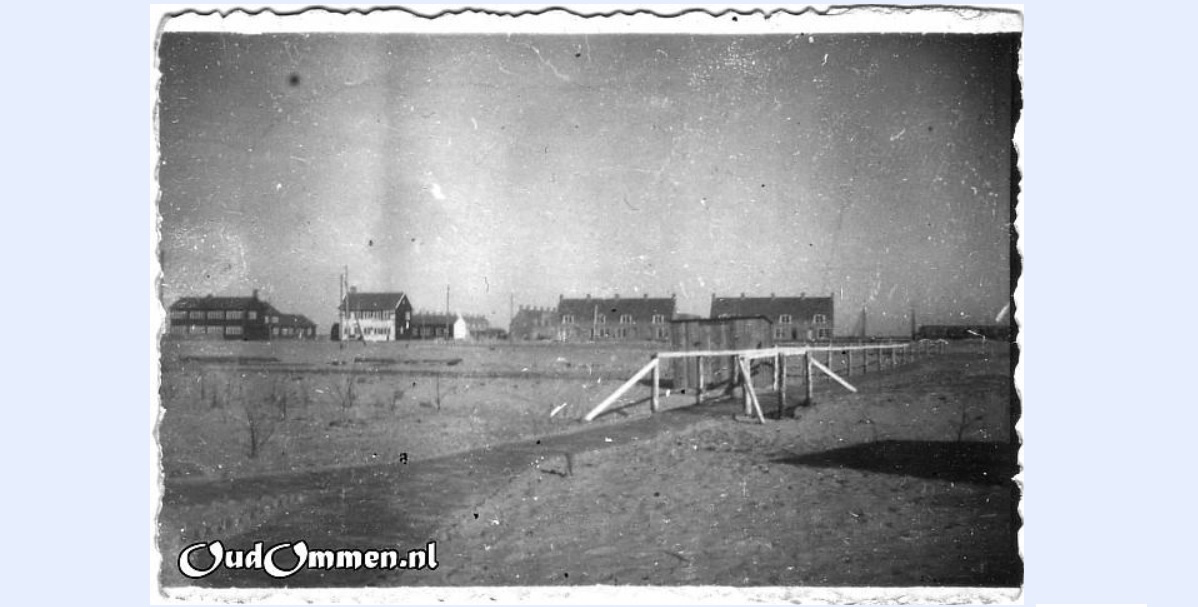
Location 17. Emmeloord. Sgt. Denny: "I went around the back of a house to find a window which I could crawl through, but all was locked. I broke it with my hand and entered the house to open the door for the others. I had cut my hand, it was bleeding and had to bind the wound with a rag. Then we searched for food and found only some old bread which we divided up. Hanley and Deason got upstairs for the beds, while Gecks and I slept in chairs".
"Next morning walking south brought us to the canal (Urkervaart) where we had hid the previous night.The canal was quite wide and Hanley could not swim. But as we looked east, about a mile up the canal was a ferry boat (location 13). We noticed two figures close by the boat, but we outnumbered them and we walked towards them... still dressed in our flying suits! As we drew closer, we hailed them in English and they immediately responded with a loud shout. They were Dutch underground. Good luck? No! I believe it was God's grace! Crossing the canal and seeing the sun rising in the East, we walked until what seemed to be an abandoned farm house. Here we sought shelter until dark. Our helpers left to go to town, returning with a car after dark. They took us to village Espel (= barrack camp Espelerbocht, location no. 26), where we had supper".
"After supper at about 10:00 PM we started out on bicycles for the small town of Markhasse (is Marknesse). Being aware of German patrols, we had one man riding about half a mile ahead of us, using a flashlight to signal in the event of German soldiers, giving us a chance to escape if necessary. By midnight we arrived (prospector barrack camp Marknesse, location 10), exhausted, but excited that were actually evading and on our way. On the first morning in Markhasse we were all four measured for civilian clothes, so that no one could tell us from the rest of the population, except for our height. All four of us were at least six foot tall and Lt. Gecks was 6'4". Our new shoes were not the most comfortable". Note: in 1944 the Americans were the tallest people in the world, the Dutch were much smaller. Now in 2017 the situation is reversed: the Dutch young men are with an average length of 6' 0" foot (1.83m) the tallest in the world, the Americans are 5' 8" (1.77m). Next move was getting out the polder. Co-pilot Frank Deason and pilot Russell Gecks came in the safehouse of the Kingma family in Vollenhove (the pilots are no. 10 and 11 on their list, see below). Hanley and Denny were housed not far away, all got false ID.

Meppel - Zwolle
After four days the evaders were given train tickets. Frank Deason mentions in his Evasion Report the name of Meppel resistance Peter van den Hurk. A Dutch guide was to be followed towards the train station of Meppel (see map above). Denny: "We walked in pairs of two, the guide was 80 ft ahead. We walked along as we owned the place. German soldiers were all around us. The train was packed with standing room only and I stood shoulder to shoulder with German soldiers. Didn't look anyone in the eyes. When the train stopped at a station (Staphorst?) several got off. A German soldier asked me something about an empty seat. I didn't reply and he let it pass. We stood all the way to Zwolle. Our guide stepped off there, followed by us. His mission was to walk us to a house about 4 miles from the station. There were people everywhere, no one paid us any attention. Finally we arrived safely".
"The next days we spent in this home, playing cards. I thought how ridiculous it was. I was there fighting a war, but now surrounded by Germans. My own mother was a full blooded German. A relative could have passed me on the trip and we wouldn't know it. After a week, our guide came back and we left for a train ride to Linne, a village just south of Roermond. In Linne we stayed in a farm house about 2 miles outside Linne".
Below: Sgt. Denny's 1st book. With his accounts of his evasion from Holland. On photo: Denny, Deason, Hanley and Gecks.
Photo taken in a safe house in Maastricht. The next stop after Linne.
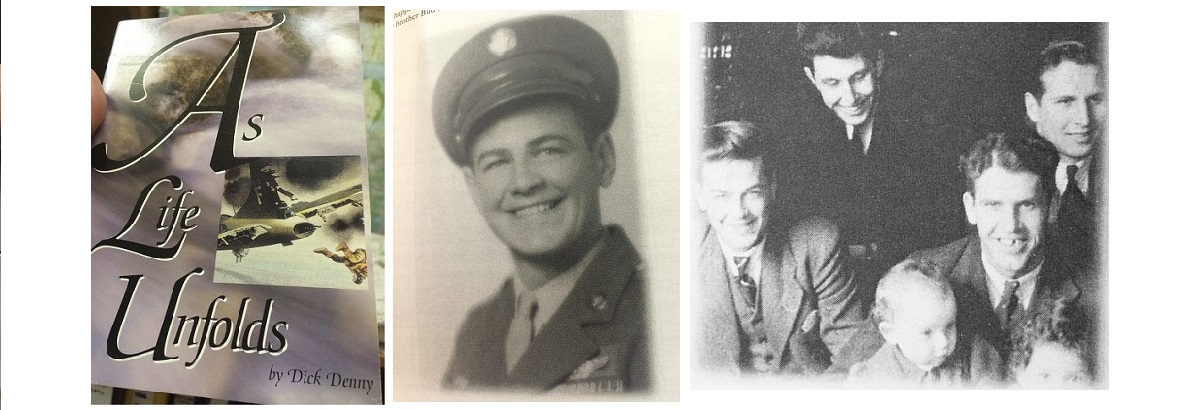
Maastricht - Through St. Peter's Mountain (the Lime Stone Caves) to Belgium.
"After some nights we took the train to Maastricht. Meeting us at the station was a new leader (guide), who led us to a castle near the Netherlands-Belgium border. Maastricht was so densely populated that we could freely move about as we grew accustomed to the place". Frank Deason mentions help from Mr. Albert Bekker of the MaBro bread company. It was very difficult to get further south, to Belgium. A reason to enter Belgium was necessary (they didn't have that) and the border crossings were heavily guarded. An underground smuggle route had to be followed.
Denny: "After about 9 days we were gathered in a group of 10-12 evadees and followed a lame smuggler who applied his trade by going through a cave between the two countries". In fact it were not caves but an ancient man made tunneling system where limestone was mined since Roman days. A maze of hundreds of miles of old tunnels with all kinds of sculptures, name graffiti and hidden chapels exists. Some parts are accessible today. It seems they went through the Canner-mountain section. "After 45 minutes walking in the darkness in the middle of the mountain, known only to a very few, the guide raised his lantern and told us to look up. These was a six foot painting of Jesus Christ hanging on the cross. A strange sense of His presence came over me. We had to crawl through a 45 feet long, very narrow and small passageway on our stomachs to get into another section" (the Belgian section). Most likely Neercanne or Canne.

Belgium
Probably a Dutch guide from Maastricht led the group to the Belgian section, where a Belgian guide took over. Another American, William Elsberry, mentions that the route through the mountain took more than a hour and that they exited on the Belgian side 1,4 miles (3km) above the fortress Eben-Emael. Close to the fort on 300 yards (300m) was a farm. In the basement of that farm he was with 11 American flyers. Denny: "We walked on on the other side, as we broke forth from the bowels of the mountain. We found ourselves standing on a ledge overlooking a magnificent valley of the Meuse river in moonlight. We followed a different man who was from that particular part of Belgium". This was probably Adolphe van Belleghen, who had a café in Petit-Lanaye. After Eben-Emael, the men left for Roclenge, Bassenge and Slins, northwest of Liège.
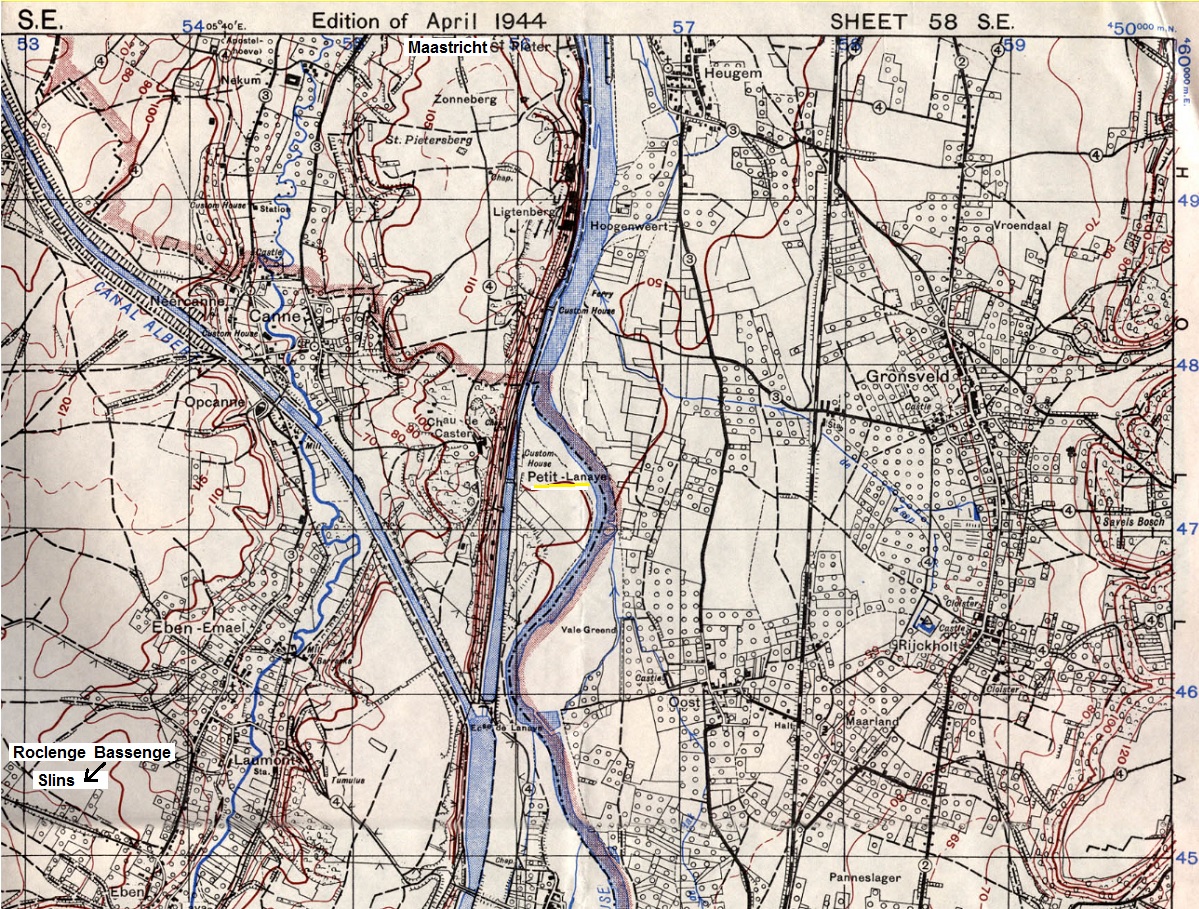
The evaders
Pilot 2Lt. Russell Gecks was underground in Bassenge (Eben-Emael), Roclenge, Slins, Herstal and the city of Liège. From there he was guided south to Fraipont. However, the invasion in Normany had started June 6st. Resistance leader Gaston Matthys of the EVA (Comète) escape line could not get the airmen in his care further down the line to Paris and then Spain. The route was blocked. Helped by Allied secret services, they set up a number of hidden locations in the woods of the Belgian Ardennes west of Bastogne. The operation of setting up the secret camps and getting the evadees into these spots was named 'Operation Marathon'. Lt. Gecks was in camps near Beffe and Porcheresse. Possibly he did not liked it there and moved on south on his own, but he did not get far. He crossed the Belgian-French border at Bagimont and was in Gespunsart, just on the French side. Then he was a bit more south in Renneville and Fraillicourt, heading for the French city of Reims. Just north of Reims, hiding for retreating German troops he encountered the advancing US Army at Auménancourt-le-Petit on 30 August 1944. Flown back in England first week of September.
Co-pilot 2Lt. Frank Deason and Radio Operator S/Sgt. Clifton Hanley stayed together and did not leave the Liège area. After Bassenge (Eben-Emael), Roclenge and Slins, their last safehouse was southeast of Liège in village Prayon. Here they were liberated by the US Army on 8 September 1944. On the 11th they were back in England (London) for debriefing. Remarkable is that Sgt. Hanley received from the Dutch resistance in the first days of his evasion, the dog-tags of Canadian Flying Officer Samuel L. McBurney. He was killed when his Lancaster ED333 (97 Sqn) crashed night 17/18 December 1942 at 4km east of Urk, nearby Hanley's bail out location. The smashed remains of this Lancaster where in a swamp with soft ground with 40cm of water. At the time, the Urk air warden could recover four bodies, but apparently (later) also found the dog tags of McBurney, which were not handed over to the Germans. McBurney's remains were recovered post war and buried in Amersfoort.
Engineer T/Sgt. Dick Denny was in Slins north of Liège for 2 months. On 6th June 1944, Denny was moved hidden in a small truck to Malempré, to a farm that was an Operation Marathon hiding location. Twenty English and American airmen were under ground there, but Denny did not feel safe. With a lot of luck not to be arrested by the German control posts, he walked back to Liège and came in contact with the underground. They found shelter for him in village Rocourt, in the farm house of Antoinette Peters and her sons Charles and George. On September 8th, Denny returned to Allied military control when he walked towards an American Jeep patrol in the centre of Rocourt. Hitch-hiked to Brussels and Paris with supply trucks and got a return flight to London 13 September. His walk north towards Sweden or south to Spain did not entirely worked out as planned, but he reached the Ardennes and succesfully evaded until liberated for 5 months to the day.
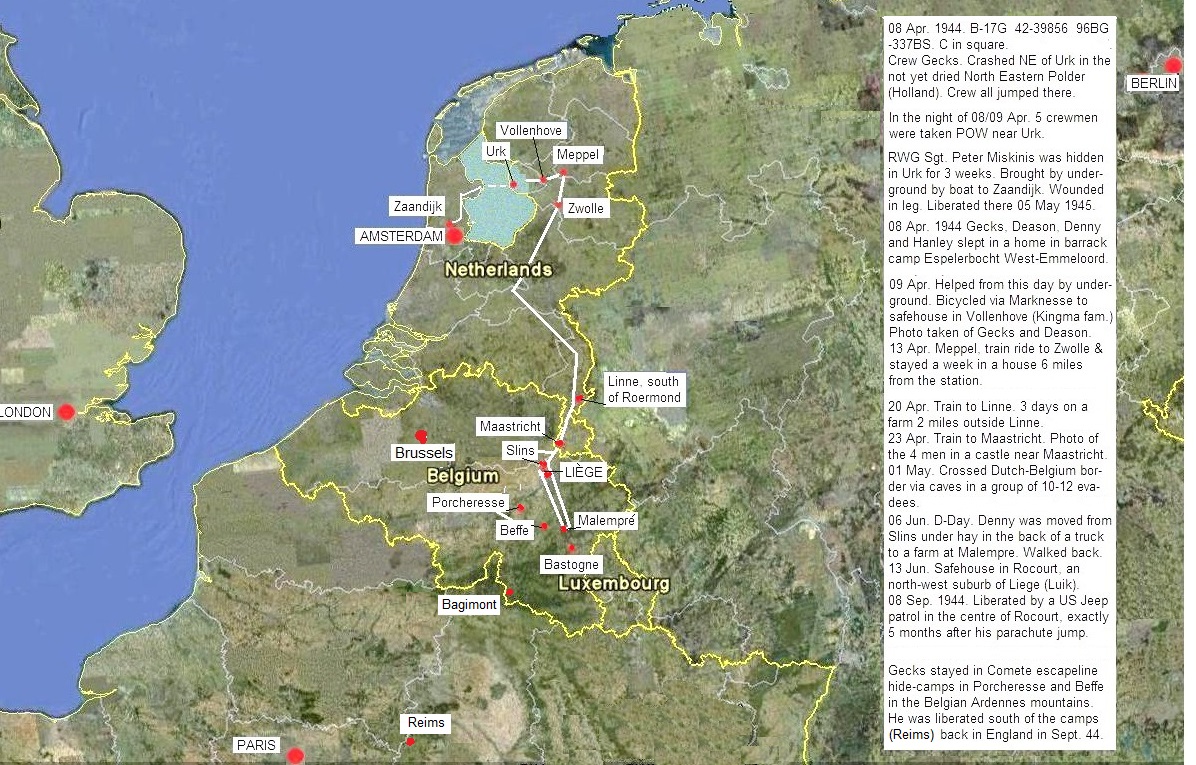
=========================
War Bonds for a Fortress - The Lane Tech of Chicago
We believe per September 1st 2017, that the B-17 paid for by the Lane Tech of Chicago school was a type F, without chin turret. This because of the time frame: Lane's war bond campaign for the bomber finalized end March 1943. From that moment, the production of the type F went on for another 4,5 months. At first, the school thought to have the required 300.000,- by March 1st (see below), at least before 'Doolittle Day' on 18 April 1943 (the anniversary of Lt. Col. Jimmy Doolittle B-25 raid on Tokio). The sum was reached around March 20, 1943. From April 1st to August/September 1943 in total 1678 Flying Fortress type F were produced. It seems logical Lane's B-17 was one of these aircraft. Other war bonds campaign in the same period also produced B-17F. And there are more indications to believe the Lane was a F, without chin turret, see further below.
This implies that Russell Geck's 42-39856 cannot be the Lane Tech of Chicago, because that was a type G with chin turret, build 21 September 1943. This B-17 may have visited Chicago airfield 15-17 October 1943, but more B-17 were in Chicago that weekend. There is no evidence that B-17G 42-39856 had name Lane Tech on the nose at any given time. What serial number and faith was of the actual Lane Tech bomber is still unknown.
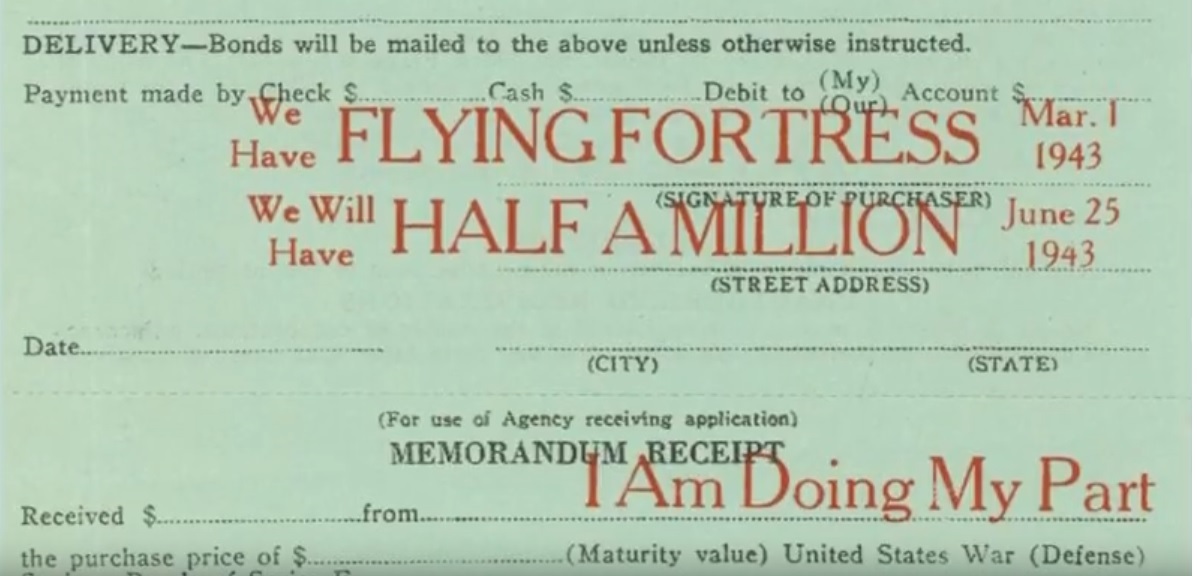
The Air Show
The Chicago airport air show was Friday to Sunday 15-17 October 1943. A B-17F with Lane Tech of Chicago on nose can have visited the show Friday 15 October. For this it must have been a late build F that came off the Boeing Seattle (BO) production line in August or first week of September 1943, serial number between 42-30935 and 42-310031. After the standard 3 to 5 weeks completion in a modification center, it is feasible that this battle ready B-17F, on route to the US East Coast (Maine), visited the Chicago air show on 15 October.
In underneath Chicago Tribute interview March 27, 1983, Ted Szalinski is quoted stating he and his also 'aircraft nut' mate Bob Dady were 15 year old Lane Tech students and bicycled 11 miles to the air show and were NOT disappointed: "There on the tarmac was a brand new B-17, camouflaged olive-drab, with emblazoned on its nose "Lane Tech of Chicago". Ted was probably early at the show. Other students and school officials came later than Ted, by the time the B-17 had left in a hurry.
The rumor it had to depart urgently because of a crises in Europe, can be true. From May to mid October 1943, the losses of the 8th Air Force in Britain were unsustainable high due to the lack of enough fighter cover. Peaking in the 2nd raid on Schweinfurt the day before the air show, Thursday 14 October, when that afternoon it transpired that another 60 bombers were lost.
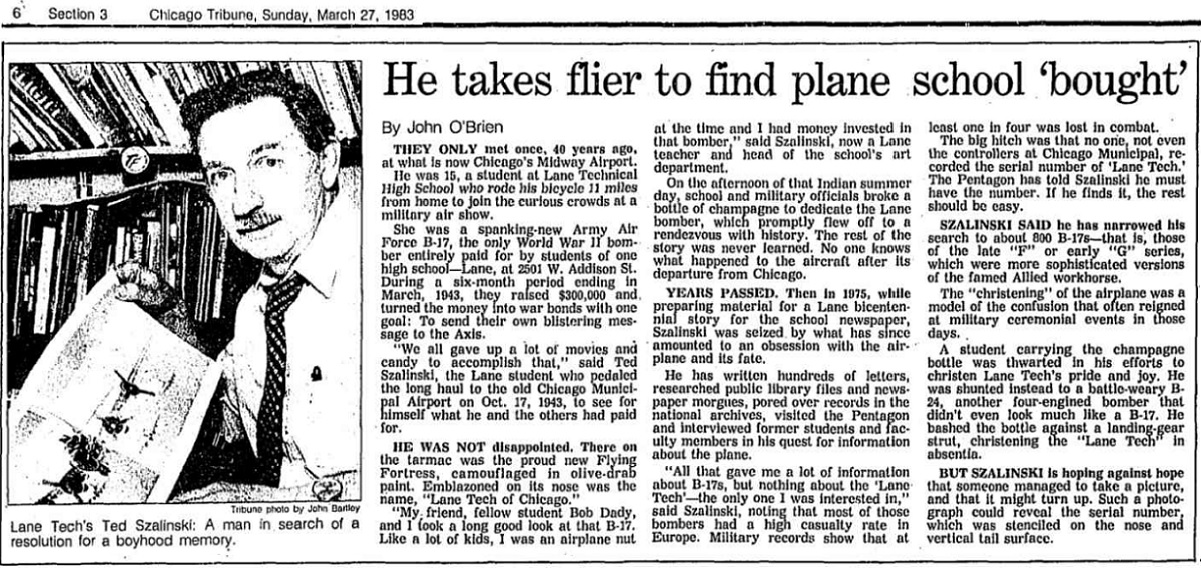
The letter
On December 4, 1943, the US Treasury Department Illinois, sent underneath letter with a doctored photo to the school. The photo shows a B-17F without chin turret and with Lane Tech of Chicago on nose. It was a faked photo, but representative for the real B-17F Lane Tech. We believe the real B-17F Lane Tech attended the airshow (briefly). If a B-17 model G with chin turret had visited the air show, this photo would have shown a mismatch in B-17 types and would not have been sent. The photo was modified, a mismatch in types would have brought attention to the photo, which could have led to expose as being a fake.

The doctored photo
The school letter states that the photo was sent to the US Treasury Illinois by the "Field Director's office in Washington D.C.". Apparently this office or behind it could arrange doctored photographs on request. Not always a real photo of a war bond plane existed. Often because they flew off into war, without ceremony. Then a photo could be delivered 'photo shopped'. Such photo depicts a same B-17F every time, but with another name inserted in the photo on the nose. The Lane Tech photo also comes from this altered series and is a fraud. The bomber in the photo is a new build B-17F leaving factory, not fully armed yet. No propellers visible. However, the B-17 in the photo is of correct type F without chin turret and with name 'Lane Tech of Chicago'. Correct for end March 1943 when Lane's war bond campaign for the Fortress ended and the 4,5 months thereafter. The photo comes as close as possible on how the real B-17F 'Lane Tech of Chicago' must have looked like.
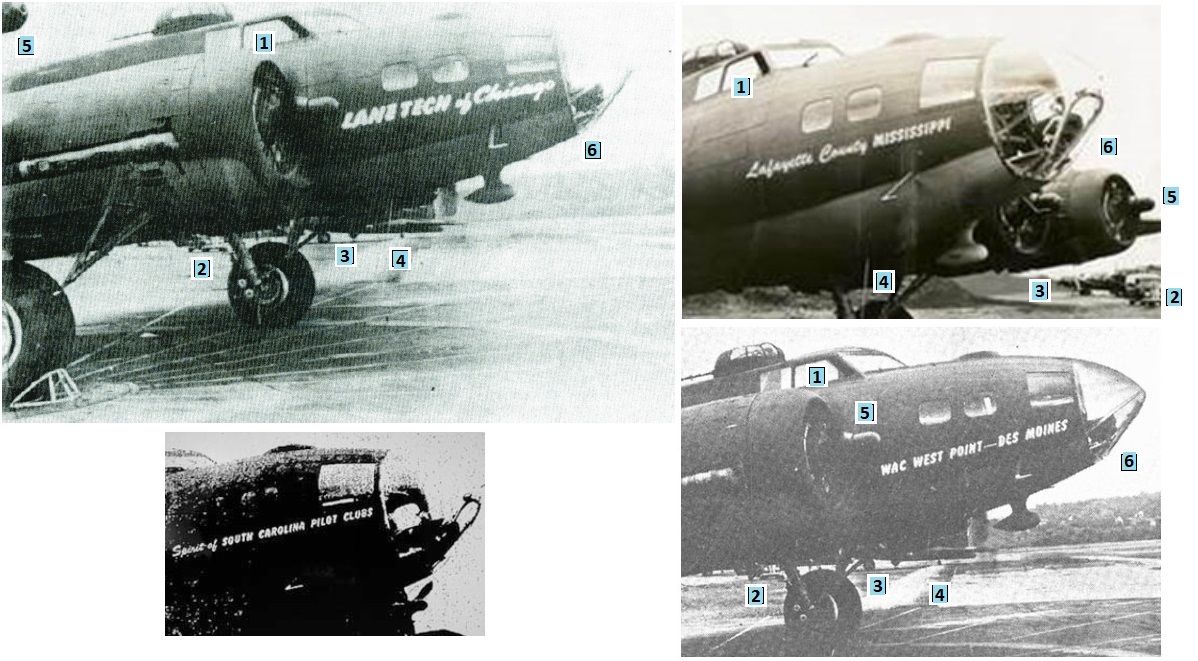
Evidence of same B-17 used for each doctored image:
1. Right window opened 3"
2. The pick-up truck
3. Other B-17
4. The vertical wire
5. No propeller blades
6. No front armament
Photos website: www.usaaf-noseart.co.uk
======
History of the B-17G 42-39856.
Subject of this article, Geck's B-17G 42-39856, came out the Douglas Aircraft Factory in Long Beach California ('DL') on 21 Sept. 943. This was six months after the Lane Tech War Bond Campaign for a B-17 had finalized. Two weeks later on 6 October 1943, the 42-39856 was further east in the USA in a modification/completion center in Great Falls, today Malmstrom Air Force Base (Montana). After that the aircraft was ready for war and it flew to the last stepping stone in the USA before England: Presque Isle in Maine (Northern Maine Regional Airport). Here it was involved in a accident on the runway with another B-17. This was on 9 October 1943 (see below). This shows that the aircraft had no intented relation with Lane Tech/Chicago at all: if the accident would not have occurred, the aircraft would have followed a strait course from factory in California, Montana, Maine, to England. Record shows that after the accident, 42-39856 was 22 October 1943 in Scott Field. This is Scott Air Force Base, St. Clair County, Illinois, southwest of Chicago. This probably after repairs. A visit to Chicago 15-17 October has been possible, but a relation with Lane Tech is not there.
List on website http://archive.li/JTZ6I source: www.mewreckchasers.com

B-17G 42-39856 AW-G in England.
On 29 October 1943 the 42-39856 was assigned to the 96 bomb group (C in square) - 337 bomb squadron (AW) in England, Snetterton Airfield. Aircraft letter in the bomb squadron was G. Below a picture taken between 29 October 1943 and 8 April 1944. During her life cycle, from moment leaving the factory 21 September 1943 until the crash 8 April 1944, no report or indication was found that this aircraft ever had a nick name or nose art. It was build well after Lane's War Bond Campaign (6 months later). The model is a G with chin turret, the Lane bomber was a F without chin turret. The 42-39856 (239856 on tail) is not the Lane Tech of Chicago.
Photo website: http://justacarguy.blogspot.nl/2017/03/one-b-17-was-bought-and-paid-for-by.html?m=1
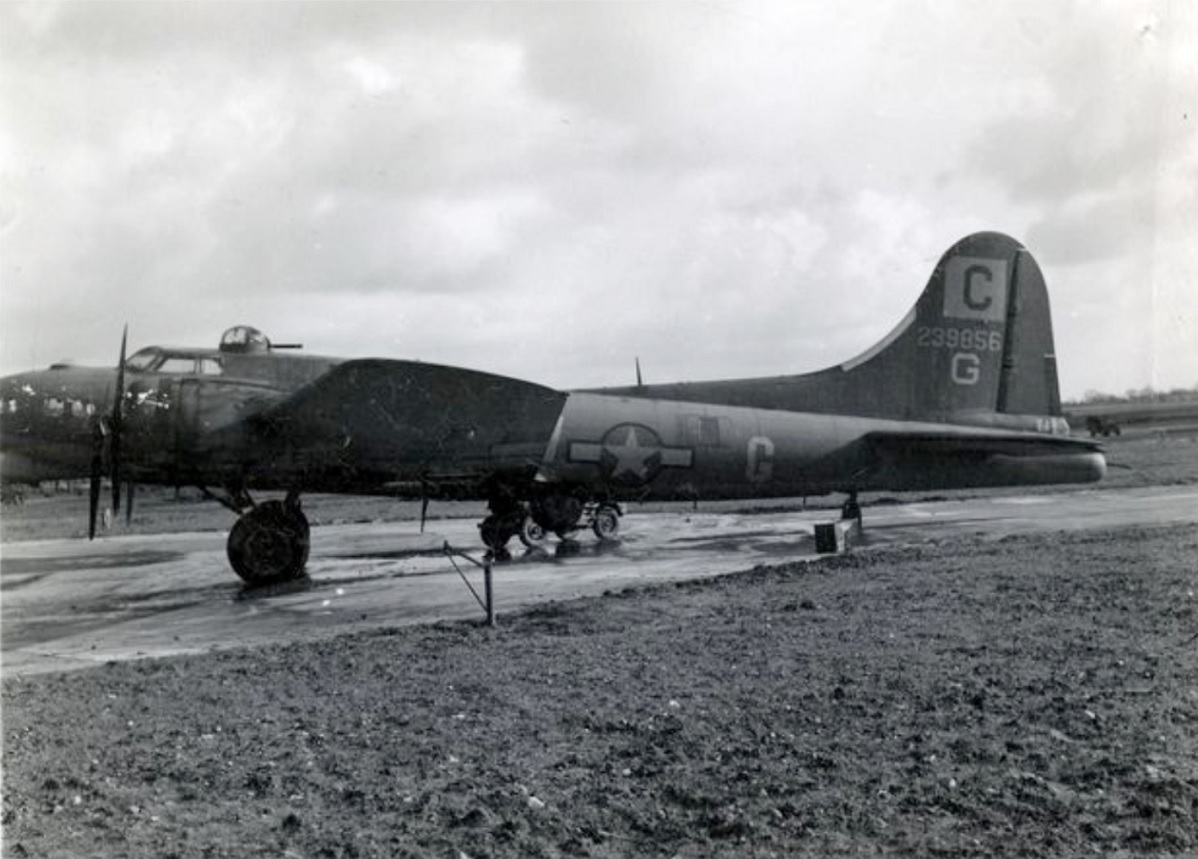
Wacky Woody
B-17G 42-39841 was build 16 September 1943 in the same serie as 42-39856. It arrived in England 9 October 1943, a week before the Chicago air show of 15-17 October 1943. In England at the 96BG-337BS it had some kind of woodpecker painted on the nose, says Bob Dennisen who also had flown the plane. A photo of the maintenance crew posing in front the nose proves this. The 42-39841 Wacky Woody was shot down 25 February 1944 on a raid to Regensburg. Pilots were William H. Lupole and co-pilot Bob Bateson. The aircraft came down in the outskirts of Saarbrücken. There is no relation with Lane Tech of Chicago.
© ZZairwar (Zuyder Zee Air War)
.